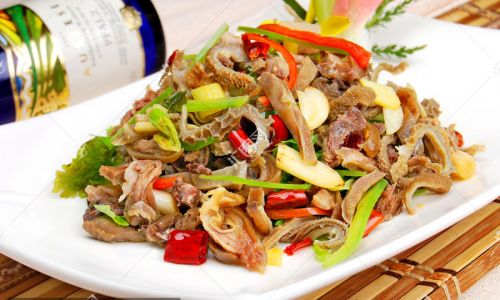In the vast tapestry of Chinese culinary heritage, few dishes embody the art of balance, texture, and bold flavor quite like stir-fried lamb offal. This humble yet revered dish, often overlooked in Western menus, is a cornerstone of regional Chinese cooking, celebrated for its ability to transform underappreciated cuts of meat into a feast for the senses. Rooted in centuries-old traditions and adapted to modern palates, stir-fried lamb offal—known in Mandarin as bào chǎo yáng zá—is a testament to the resourcefulness and creativity of Chinese chefs. This article explores the history, cultural significance, preparation techniques, and evolving global appeal of this dynamic dish.

The Cultural Tapestry of Lamb Offal
Lamb offal, or yáng zá (literally “lamb miscellany”), refers to the organs and entrails of the animal, including the liver, kidneys, heart, lungs, intestines, and stomach. In many Western cultures, these cuts are often discarded or relegated to niche dishes, but in Chinese cuisine, they are treated with reverence. This practice stems from a deep-seated cultural philosophy of “bu yao lang fei” (不浪费), or “do not waste,” which emphasizes using every part of the animal as a sign of respect for life and sustainability.
Historically, lamb offal was a staple for nomadic herders in northern China, particularly in regions like Xinjiang, Inner Mongolia, and Gansu, where sheep were a primary source of sustenance. These communities developed ingenious ways to preserve and cook offal, turning what might be considered scraps into nourishing, flavorful meals. Over time, stir-frying emerged as the preferred method, as it allowed for quick cooking over high heat, preserving the offal’s delicate texture while infusing it with aromatic spices.
The Anatomy of Flavor: Key Ingredients
At its core, stir-fried lamb offal is a study in contrasts: tender and chewy, spicy and savory, earthy and bright. The dish’s complexity begins with the selection of ingredients.
-
Lamb Offal Varieties:
- Liver: Rich and velvety, lamb liver adds a mineral depth.
- Kidneys: Delicate and slightly metallic, they are often marinated to mellow their flavor.
- Heart: Meaty and firm, it contributes a robust texture.
- Intestines: When cleaned meticulously, they offer a satisfying crunch.
- Lungs: Light and airy, they absorb flavors readily.
- Stomach (Tripe): Chewy and gelatinous, it provides a unique mouthfeel.
-
Aromatics and Spices:
- Garlic and Ginger: These form the flavor base, providing pungency and warmth.
- Dried Chilies: Crushed or sliced, they add fiery heat.
- Cumin: Toasted and ground, it imparts a smoky, nutty aroma.
- Sichuan Pepper: Its numbing, citrusy notes elevate the dish’s complexity.
- Fermented Black Beans: Salty and umami-rich, they bridge the ingredients.
- Soy Sauce and Vinegar: For depth and acidity.
-
Vegetables:
- Scallions: Cut into batons, they add freshness.
- Bell Peppers: Thinly sliced, they contribute sweetness and color.
- Onions: Caramelized for sweetness or kept crisp for crunch.
The Alchemy of Stir-Frying
Stir-frying is a culinary technique that demands precision, speed, and intuition. The process begins with velveting—a method where the offal is marinated in a mixture of soy sauce, rice wine, cornstarch, and baking soda. This step tenderizes the meat and seals in moisture, ensuring it remains juicy during cooking.
The wok, heated until smoking, becomes the stage for a high-speed dance. A splash of oil is added, followed by aromatics like garlic, ginger, and chili, which sizzle and release their fragrance. The marinated offal is then tossed into the wok, searing quickly to lock in flavors. The heat is intense—often exceeding 400°F (200°C)—to achieve the coveted wok hei (breath of the wok), a smoky essence that permeates the dish.

As the offal cooks, vegetables and spices are added in rapid succession. The dish is finished with a drizzle of vinegar, a sprinkle of cilantro, and a final toss to coat everything in the glossy sauce. The result is a medley of textures and flavors: the tender liver, the chewy tripe, the crispy intestines, all bathed in a spicy, aromatic sauce.
Regional Variations and Modern Twists
While the core principles of stir-fried lamb offal remain consistent, regional variations abound. In Xinjiang, a Muslim-majority region, the dish often incorporates cumin and lamb fat, reflecting the area’s Central Asian influences. In Sichuan, chefs amplify the heat with fiery chili oil and numbing Sichuan pepper, creating a dish that tingles the tongue. In Beijing, the preparation might be more restrained, with a focus on the natural flavors of the offal.
Modern chefs are also experimenting with global twists. Some fuse the dish with Korean flavors, adding gochujang or kimchi, while others incorporate Mediterranean herbs like rosemary or oregano. In trendy fusion restaurants, lamb offal might be served atop crispy flatbreads or paired with avocado crema, appealing to adventurous foodies.
Health and Nutritional Benefits
Despite its humble reputation, lamb offal is a nutritional powerhouse. Rich in protein, iron, vitamin B12, and zinc, it offers a host of health benefits. Lamb liver, for example, is one of the best dietary sources of vitamin A, essential for eye health and immune function. Kidneys are packed with selenium, a potent antioxidant, while the heart provides Coenzyme Q10, which supports cardiovascular health.
However, offal is also high in cholesterol and purines, which can be problematic for those with gout or heart conditions. Moderation is key, and proper preparation—such as trimming excess fat and avoiding overcooking—can mitigate these concerns.
The Ritual of Eating
In China, stir-fried lamb offal is often enjoyed in communal settings, served alongside steaming bowls of rice or hand-pulled noodles. The dish’s vibrant colors and bold flavors make it a centerpiece of family gatherings and celebrations. Diners are encouraged to savor the interplay of textures, pairing the tender liver with a crisp piece of intestine or a bite of spicy chili.
The act of eating offal also carries a certain rustic charm. It requires a willingness to embrace the less-glamorous parts of the animal, a trait that many Chinese diners find endearing. In an era of hyper-processed foods, stir-fried lamb offal represents a return to wholesome, unpretentious cooking.
Challenges and Misconceptions
Despite its cultural significance, lamb offal faces challenges in the global marketplace. In Western countries, where offal is less commonly consumed, the dish is often met with skepticism. Concerns about texture, flavor, and safety (if not properly cleaned) can deter potential diners. However, advocates argue that these perceptions are largely rooted in unfamiliarity. With proper preparation and education, lamb offal can win over even the most hesitant eaters.

Another hurdle is sustainability. As global demand for lamb rises, there is pressure to raise animals more efficiently, sometimes at the expense of traditional, pasture-based farming. This can affect the quality and flavor of the offal, as well as the livelihoods of herders who rely on these practices.
The Future of Stir-Fried Lamb Offal
As global food cultures continue to intersect, stir-fried lamb offal is poised for a renaissance. Food bloggers, chefs, and home cooks are rediscovering its versatility, experimenting with new flavor profiles and presentation styles. In cities like London, New York, and Sydney, pop-up restaurants dedicated to offal cuisine are gaining traction, proving that there is a growing appetite for adventurous eating.
Moreover, the rise of nose-to-tail cooking—a movement that advocates using every part of the animal—has aligned perfectly with the ethos of lamb offal. Chefs are framing the dish not as a relic of the past, but as a forward-thinking choice for eco-conscious diners.
Conclusion: A Dish of Enduring Legacy
Stir-fried lamb offal is more than a meal—it is a narrative etched in fire and spice. It tells the story of a culture that honors its resources, celebrates community, and finds beauty in the unconventional. As the world becomes more interconnected, this humble dish is emerging as a bridge between traditions, inviting diners to savor the past while embracing the future. Whether enjoyed in a bustling Beijing night market or a trendy Brooklyn bistro, stir-fried lamb offal remains a testament to the enduring power of flavor and tradition.
In the end, the dish’s magic lies not just in its taste, but in its ability to transcend borders, generations, and culinary prejudices. It is a reminder that sometimes, the most extraordinary experiences are found in the most unexpected places—or plates.






0 comments